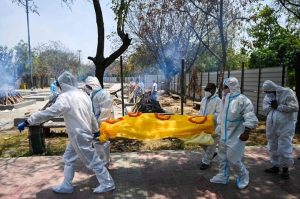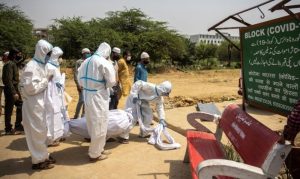24-05-2021
Bureau Report
NEW DELHI: India has crossed 300,000 coronavirus deaths, the third country after the United States and Brazil to hit the grim figure, as it battles a huge second wave of infections now affecting the poorer countryside.
India’s health ministry on Monday reported 4,454 coronavirus-related deaths over the last 24 hours, with the total death toll now standing at 303,720 after adding 50,000 deaths in just fewer than two weeks.
Daily coronavirus infections rose by 222,315, taking the country’s caseload to 26.75 million, according to the health ministry data.
 The milestone came as slowed vaccine deliveries mar the country’s fight against the pandemic, forcing many to miss their shots, and a rare “black fungus” infection affecting COVID-19 patients worrying the doctors.
The milestone came as slowed vaccine deliveries mar the country’s fight against the pandemic, forcing many to miss their shots, and a rare “black fungus” infection affecting COVID-19 patients worrying the doctors.
Many experts however believe the real toll is much higher, particularly as the disease spreads into rural areas where the majority of the 1.35 billion population lives and where health facilities and record-keeping is poor.
A journalist reporting from New Delhi said Indian journalists, doctors and crematoriums all say many deaths are not being counted.
“The official death toll only takes into account people, who are dying in hospitals, but most Indians don’t die in hospitals, they die at home. And only around 22 percent of deaths in the country are medically certified,” she said.
States halt vaccination due to shortage
Several Indian states have halted the COVID-19 vaccination drive for those in the 18-44 age group due to a shortage of vaccine supplies, regional officials confirmed on Sunday.
 States where vaccinations for this age group have been stopped include Chhattisgarh, New Delhi, Karnakata, Maharashtra and Rajasthan, all among the worst-affected by a current second wave of the pandemic.
States where vaccinations for this age group have been stopped include Chhattisgarh, New Delhi, Karnakata, Maharashtra and Rajasthan, all among the worst-affected by a current second wave of the pandemic.
“The vaccination drive is not going well at all. There are very severe shortages of vaccines and the (federal) government has told states to make their own arrangements with vaccine manufacturers, both local and foreign,” said journalist.
People aged 45 and above are also finding it difficult to get their second dose in several regions, with a number of vaccination centers remaining closed in cities like New Delhi, Mumbai and Pune. Signs posted outside these centers said supplies had run out.
“Delhi is also running short of Covaxin doses for the 45-plus age group, we have supplies for just one more day, we have a week’s supply of Covishield,” said Atishi of Delhi’s ruling Aam Aadmi Party.
The country began inoculating its 1.3 billion population on January 16 with the two vaccines approved by its drugs regulator.
These are Covishield, which is the name under which the AstraZeneca vaccine is produced in India by the Pune-based Serum Institute of India, and Covaxin, manufactured by Hyderabad-based Bharat Biotech.
 The government had planned to vaccinate 300 million people by July but a little more than 195 million shots have been administered so far. Only 43 million people have received the required two shots.
The government had planned to vaccinate 300 million people by July but a little more than 195 million shots have been administered so far. Only 43 million people have received the required two shots.
The number of vaccines being administered daily has dropped during the past month from 3.2 million doses on April 26 to 2.4 million on May 11 and to 1.5 million on Saturday, government data showed.
“Vaccination is really the only answer and Indians are already paying a heavy price for the way the government has gone about planning, pricing and the rollout,” said virologist Dr T Jacob John.
Federal government representatives have said the glitch in vaccine supplies was temporary and there would be around two billion doses of vaccines available between June and December.
However experts say the government is not likely to hit that goal, pointing out that four of the vaccines the government was basing its projections on are still in the clinical trials stage.
“We don’t know whether those would be licenced and when,” epidemiologist Dr Chandrakant Lahariya was quoted as saying by The Hindu newspaper.
Lahariya said a realistic estimate of vaccine availability between August and December this year would be around 1.3 billion doses.
 Pressmediaofindia
Pressmediaofindia




